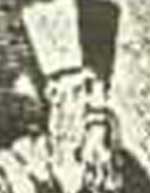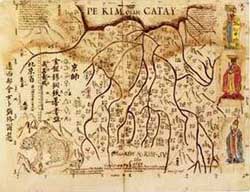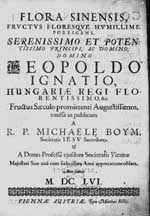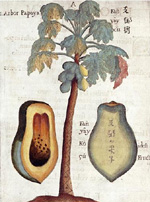Sinological Profiles
Michael Boym
1612 (Poland) - 1659 (Thailand)
Much was done by the early Jesuit missionaries to inform a European audience of their discoveries (thus producing an intellectual sensation in Renaissance Europe), and also to equip themselves with dictionaries and grammars for their labors in China. Michael Boym seems to have been the first to publish learning aids in such a way as to make those tools themselves accessible to Europeans, as the basis for an expertise in Chinese language and culture which was not simply a function of missionary endeavor in China. Boym was a Polish missionary who arrived in China in 1646, shortly after the official establishment of the Ching dynasty, but while there was still a Ming government in exile. From Hainan he went to Macao in 1650 as an agent of the exiled Ming; in 1658 he went on to Thailand. Being identified with the proscribed Ming, he could not enter China, and died in 1659 at the Chinese-Thai border.
The dictionaries attributed to him were both published posthumously: a Chinese-Latin one of 1667 and a Chinese-French version of 1670; the attribution of both has been disputed.
Boym undoubtedly produced maps of China, like the one above, and
a work on Chinese flora (along with a few animals), which was published in Vienna in 1656, and other works of medical relevance. The warm-climate character of these is compatible with Boym's own geographical range, as witness this illustration of the papaya tree:
and these works at least are indisputably genuine. Their publication is a Sinological event in its own right, and attests a certain level and direction of European interest in China in the mid 17th century.
References
- Paul Pelliot. Michael Boym. TP v31 (1935) 95-151 (affirms the attribution of the dictionary to Boym).
- Walter Simon. The Attribution to Michael Boym of Two Early Achievements of Western Sinology. AM ns v7 (1959) 165-169 (disputes Pelliot's conclusion)
- Boleslaw Szczésniak. The Beginnings of Chinese Lexicography in Europe, With Particular Reference to the Work of Michael Boym (1612-1659). Denis Sinor (ed), American Oriental Society Middle West Branch Semi-Centennial Volume (1969) 217-227
9 June 2004 / Contact The Project / Exit to Sinology Page



